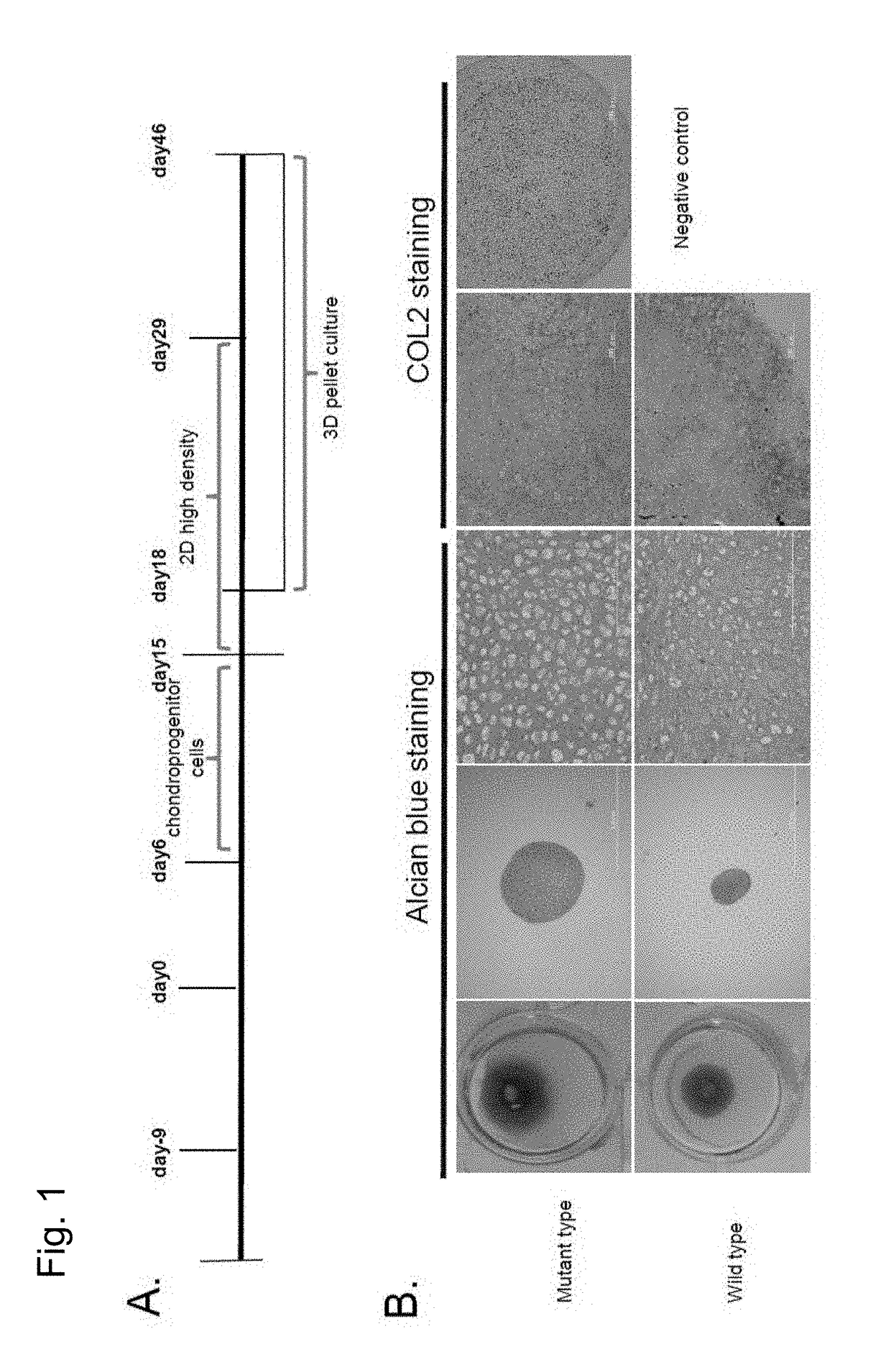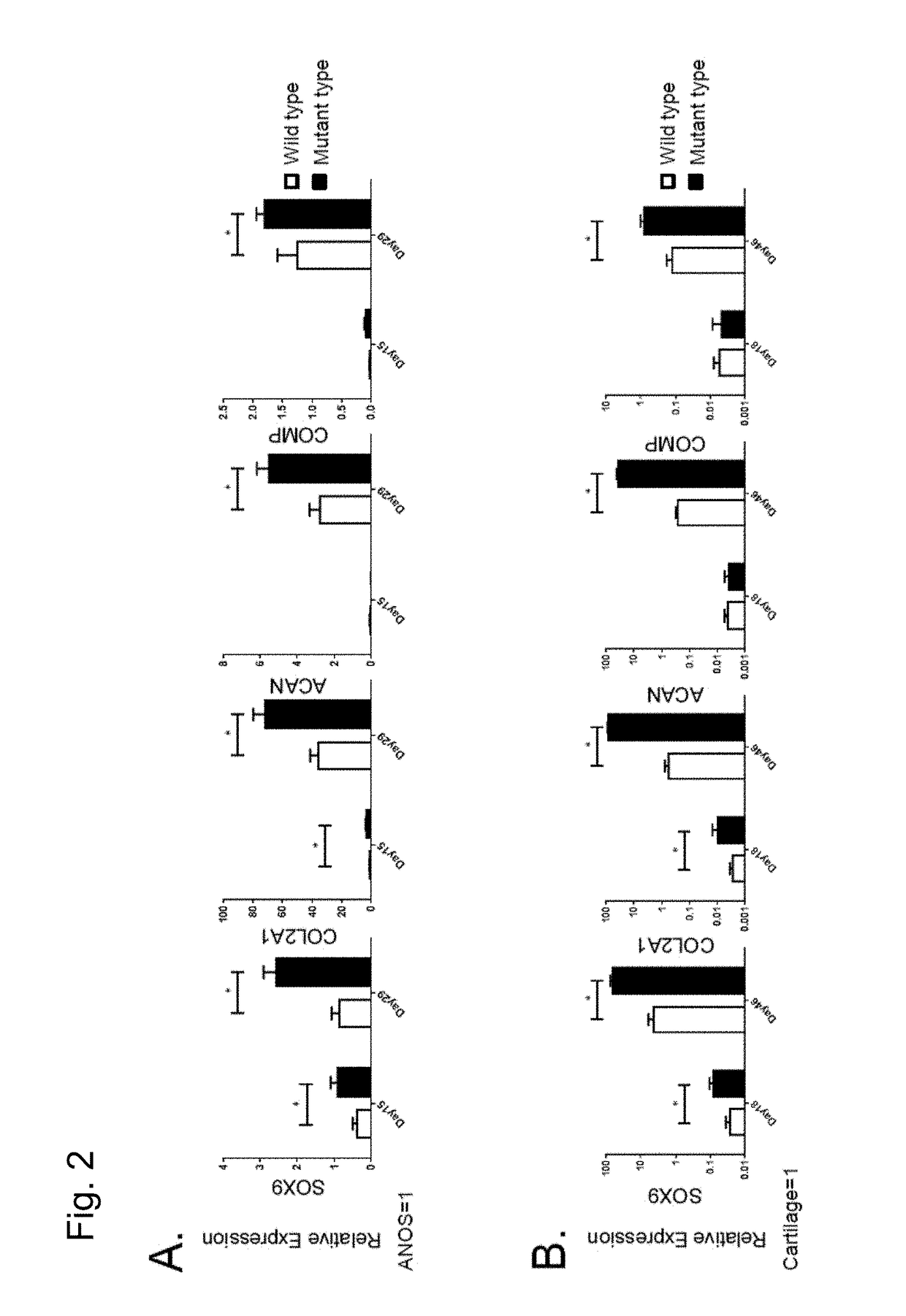Preventive and therapeutic drug for cartilaginous hyperplasia and method of screening for the same
a cartilaginous hyperplasia and therapeutic drug technology, applied in the direction of drug composition, post-translational modification detection, instruments, etc., can solve the problems of insufficient effectiveness and no reports of successful in vitro reproduction of the pathological condition of nomid
- Summary
- Abstract
- Description
- Claims
- Application Information
AI Technical Summary
Benefits of technology
Problems solved by technology
Method used
Image
Examples
example 1
[0120]All of the experiments described below were conducted with the approval of the ethics committee of Kyoto University. In addition, sampling from patients was conducted with the preliminary acquisition of informed consent in accordance with the Declaration of Helsinki. iPS cells were produced from two NOMID patients having NLRP3 somatic mosaics (p.Tyr570Cys and p.Gly307Ser). At least three clones of wild-type NLRP3 iPS cells (hereinafter referred to as “wild-type iPS cells”) and mutant-type NLRP3 iPS cells (hereinafter referred to as “mutant-type iPS cells”) were established from each patient and used for the experiments. Every experiment described below was conducted by comparing wild-type cells and mutant-type cells having isogenic backgrounds.
[0121]iPS cells were produced by the following method. Specifically, each of the obtained human dermal fibroblasts (HDFs) was cultured in DMEM (Nacalai Tesque) medium supplemented with 10% FBS (Invitrogen), 0.5% penicillin, and streptomy...
example 2
1) Neural Crest Cell Induction (Days 0-8)
[0122]The iPS cells obtained in Example 1 were induced to differentiate into neural crest cells via feeder-free culture. First, the feeder cells were removed using CTK (0.25% Trypsin (Life Technologies), 0.1 mg / ml collagenase IV (Life Technologies), 1 mM CaCl, 20% (v / v) KSR), followed by washing with PBS. Then, the iPS cells were recovered using a scraper, suspended in mTeSR medium (mTeSR Basal Medium (400 ml), 5× Supplement (100 ml), Penicillin / Streptomycin (2.5 ml)) (STEMCELL Technology), and pipetted once. Subsequently, a Matrigel-coated dish (prepared by applying a Matrigel stock solution (×50) (BD Biosciences) diluted with DMEM / F12 medium (Life Technologies) to a dish) was stored overnight at 4° C. Matrigel was removed 36 to 60 minutes before the use of the cells. The cells were dried and seeded (5×104 / 10-cm dish) on mTeSR medium (10 ml) and cultured at 37° C. in 5% CO2. Two days later, the medium was replaced with neural crest induction...
example 3
[0129]In order to further examine the details of the state of chondrocytes obtained through differentiation induction by the methods (2D micromass culture and 3D pellet culture) used in Example 2, chondroprogenitor cells before induction of chondrocytes and induced chondrocytes were examined to analyze the expression state of genes specifically expressed in chondrocytes (chondrocyte-specific genes). Gene expression analysis was conducted using the following method.
[0130]mRNA was isolated from each cell using an RNeasy Mini Kit (Qiagen). cDNA was synthesized via reverse transcription using 1 μg of the obtained total RNA as a template and a Superscript III reverse transcriptase (Invitrogen). A standard curve for quantitative real-time PCR was created to conduct analysis. Real-time PCR analysis was conducted using a Power SYBR Green qPCR mastermix (Invitrogen) and a StepOne real-time PCR system (ABI) for quantitative determination. Table 1 lists the primer sequences and assay IDs.
[0131...
PUM
| Property | Measurement | Unit |
|---|---|---|
| concentration | aaaaa | aaaaa |
| concentration | aaaaa | aaaaa |
| concentration | aaaaa | aaaaa |
Abstract
Description
Claims
Application Information
 Login to View More
Login to View More - R&D
- Intellectual Property
- Life Sciences
- Materials
- Tech Scout
- Unparalleled Data Quality
- Higher Quality Content
- 60% Fewer Hallucinations
Browse by: Latest US Patents, China's latest patents, Technical Efficacy Thesaurus, Application Domain, Technology Topic, Popular Technical Reports.
© 2025 PatSnap. All rights reserved.Legal|Privacy policy|Modern Slavery Act Transparency Statement|Sitemap|About US| Contact US: help@patsnap.com



